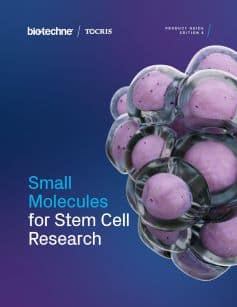CRISPR Reagents
CRISPR is a technology for the targeted editing and regulation of genes that can be applied to a number of biological systems. Tocris offers small molecules that can enhance the efficiency of the CRISPR-mediated gene editing process.
| Cat. No. | Product Name / Activity |
|---|---|
| 7755 | Asunaprevir |
| Used to control CRIPSR-Cas9 via the SMASh tag system; also SARS-CoV-2 and HCV antiviral | |
| 7825 | AZD 7648 |
| Enhances CRISPR-mediated HDR efficiency; potent and selective DNA-PK inhibitor | |
| 5199 | AZD 7762 hydrochloride |
| Enhances CRISPR-Cpf1-mediated genome editing; also potent and selective ATP-competitive Chk1 and Chk2 inhibitor | |
| 7153 | BRD 0539 |
| Cell permeable and reversible Cas9 inhibitor | |
| 1231 | Brefeldin A |
| Enhances CRISPR-mediated HDR efficiency | |
| 3412 | (Z)-4-Hydroxytamoxifen |
| Activates intein-linked inactive Cas9, reducing off-target CRISPR-mediated gene editing | |
| 4840 | KU 0060648 |
| Enhances HDR efficiency and attenuates NHEJ frequency | |
| 2197 | L-755,507 |
| Enhances CRISPR-mediated HDR efficiency | |
| 1228 | Nocodazole |
| Enhances HDR efficiency; also increases Cas9-mediated gene editing frequencies | |
| 2828 | NU 7026 |
| Improve HDR-mediated editing in HSCs | |
| 3712 | NU 7441 |
| Enhances HDR efficiency and attenuates NHEJ frequency | |
| 7806 | preQ1-alkyne |
| preQ1 with alkyne handle for click chemistry | |
| 4181 | Ro 3306 |
| Improves HDR-mediated editing in HSCs | |
| 5342 | SCR7 pyrazine |
| Enhances HDR efficiency | |
| 1406 | Trichostatin A |
| Enhances CRISPR-Cas 9 gene editing of human iPSCs; potent histone deacetylase inhibitor | |
| 5493 | XL 413 hydrochloride |
| Improve HDR-mediated editing in HSCs |
CRISPR (clustered regularly interspaced short palindromic repeats) is a technology for the targeted editing and regulation of genes that can be applied to a number of biological systems. Tocris offers small molecules that can enhance the efficiency of the CRISPR-mediated gene editing process.
CRISPR are sections of prokaryotic DNA that mediate an acquired immune response against invading plasmids and viruses. The CRISPR locus is composed of Cas (CRISPR associated) genes, a leader sequence and repeat spacer arrays (CRISPR repeats). The Cas genes encode nucleases that are capable of cleaving DNA. In type II CRISPR systems, invading DNA is detected by Cas1/2, which inserts a portion of the invading DNA into the cell's CRISPR array, between the CRISPR repeats, as a protospacer. The CRISPR array is then transcribed to form crRNA, which forms a complex with transactivating (tra)crRNA and Cas9. The protospacer section of the crRNA then binds to the complementary sequence on the invading DNA, which is cleaved by Cas9.
CRISPR Prokaryotic Host Defense & Gene Editing Technique

Figure 1: Schematic showing the CRISPR-Cas system as a prokaryotic host defense mechanism and as a gene editing technique. The CRISPR system mediates an acquired immune response against invading plasmids and viruses in prokaryotes, and has been adapted for the insertion and deletion of genes and DNA sequences in eukaryotic cells.
The CRISPR system has been adapted to create a technique capable of targeted gene editing at specific locations in the genome. The first step of gene editing is to perform a double stranded break (DSB) at the desired DNA sequence. This is achieved by designing RNA guided nucleases. In their simplest form, Cas9 is complexed with a guide RNA (gRNA), which consists of a crRNA and tracrRNA. The gRNA contains a complementary sequence to the DNA sequence of interest, and therefore guides Cas9 to the desired location. Cas9 then cleaves the DNA to create a DSB.
DSBs can be repaired by endogenous non-homologous end-joining (NHEJ) and homology-directed repair (HDR). CRISPR-Cas9-mediated genome editing through NHEJ is imprecise but can reach efficiencies of 20-60%, whereas gene editing by HDR is more precise but has only been shown to reach 0.5-20% efficiency. As HDR is more precise than NHEJ, improving the efficiency of HDR is vital for the use of the CRISPR-Cas9 system in many applications. Recent research has demonstrated that small molecules can enhance the efficiency of HDR-mediated gene editing. The β3 adrenergic receptor partial agonist L-755,507 has been shown to enhance the efficiency of HDR-mediated GFP insertion and point mutations by 3-fold and 9-fold, respectively in pluripotent stem cells. The small molecule SCR7 pyrazine has also been shown to enhance HDR-efficiency, enhancing insertion of short DNA fragments by up to 19-fold. Small molecules that enhance HDR efficiency could be integral to the application of the CRISPR-cas9 gene editing system.
Literature for CRISPR Reagents
Tocris offers the following scientific literature for CRISPR Reagents to showcase our products. We invite you to request* your copy today!
*Please note that Tocris will only send literature to established scientific business / institute addresses.
